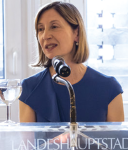“These plasma cells in their niches are completely protected against conventional therapies,” says Dr. Radbruch. “They are not dividing anymore so they are resistant to radiation, resistant to steroids, resistant to biological—[or at least] available biologicals.”
Dr. Radbruch’s vision for future research is to figure out how to isolate that portion of the cell that houses a memory for inflammation. The idea being that once segregated, it could be targeted for antiinflammatory treatment.
“The aim is now to separate the pathogenic memory for the inflammation from the protective memory against infection and then target selectively the pathogenic memory for the inflammation,” he says.
For Dr. Radbruch, attending the ceremony and receiving the Carol Nachman Prize in Wiesbaden, Germany, held added interest, given the city’s historic background as a place of resorts designed to treat people with rheumatoid arthritis.
“It was a very good feeling in the sense that I’m not a rheumatologist by training,” says Dr. Radbruch about his selection. “I’m an immunologist and I had to adapt to this kind of research also. I think it is very good to see what has been done over the years is finally recognized by the community of rheumatologists.”
Catherine Kolonko is a medical writer based in California.
